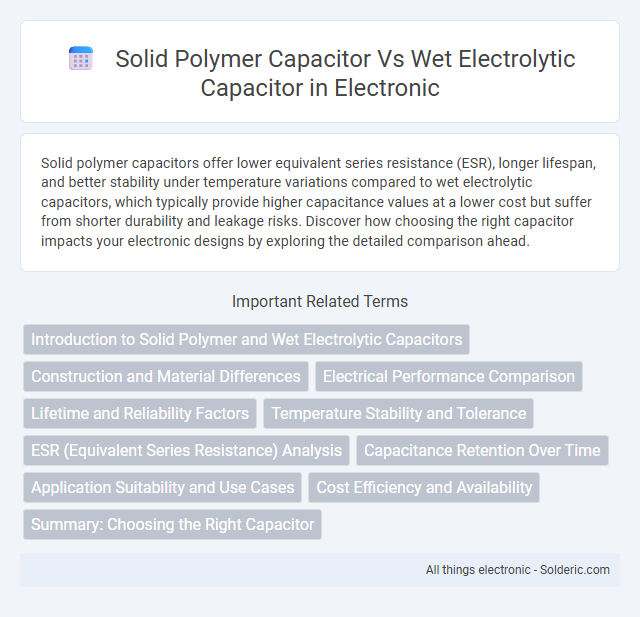Solid polymer capacitors offer lower equivalent series resistance (ESR), longer lifespan, and better stability under temperature variations compared to wet electrolytic capacitors, which typically provide higher capacitance values at a lower cost but suffer from shorter durability and leakage risks. Discover how choosing the right capacitor impacts your electronic designs by exploring the detailed comparison ahead.
Comparison Table
| Feature | Solid Polymer Capacitor | Wet Electrolytic Capacitor |
|---|---|---|
| Electrolyte Type | Solid conductive polymer | Liquid (wet) electrolyte |
| Lifetime | Longer (up to 10,000+ hours) | Shorter (1,000-5,000 hours) |
| Equivalent Series Resistance (ESR) | Low ESR | Higher ESR |
| Temperature Range | -55degC to 125degC | -40degC to 85degC |
| Leakage Current | Very low leakage | Higher leakage current |
| Size | Smaller, compact profile | Larger, bulkier |
| Reliability | High reliability, stable capacitance | Lower reliability, capacitance may degrade |
| Applications | High-frequency circuits, power supplies, automotive electronics | General purpose, bulk energy storage |
Introduction to Solid Polymer and Wet Electrolytic Capacitors
Solid polymer capacitors utilize conductive polymer as the electrolyte, offering lower equivalent series resistance (ESR) and improved thermal stability compared to wet electrolytic capacitors, which use liquid electrolyte for charge storage. Wet electrolytic capacitors provide higher capacitance values and are widely used in power supply filtering but tend to have shorter lifespans and greater leakage currents. Your choice depends on application requirements like lifetime, frequency response, and size constraints.
Construction and Material Differences
Solid polymer capacitors utilize a conductive polymer as the electrolyte, forming a stable, solid-state structure that enhances reliability and reduces ESR (Equivalent Series Resistance) compared to wet electrolytic capacitors. Wet electrolytic capacitors contain a liquid electrolyte that can evaporate or leak over time, potentially leading to shorter lifespans and decreased performance under high temperatures. Your choice between these capacitors should consider the solid polymer's superior durability and efficiency versus the wet electrolytic's typically higher capacitance values and cost-effectiveness.
Electrical Performance Comparison
Solid polymer capacitors exhibit lower equivalent series resistance (ESR) and higher ripple current ratings compared to wet electrolytic capacitors, resulting in improved efficiency and thermal stability in power supply circuits. Wet electrolytic capacitors often have higher capacitance values and voltage ratings but suffer from shorter lifespans and greater performance degradation under high-temperature conditions. Your choice between these capacitors should consider the specific electrical performance needs such as stability, ESR, and operating temperature range for optimal circuit reliability.
Lifetime and Reliability Factors
Solid polymer capacitors exhibit superior lifetime and reliability compared to wet electrolytic capacitors due to their stable solid electrolyte, which resists drying out and reduces equivalent series resistance (ESR) over time. Wet electrolytic capacitors often face shorter lifespans caused by electrolyte evaporation, leading to increased ESR and eventual failure under high temperature or high ripple current conditions. Your choice of capacitor should consider these factors to ensure long-term performance and durability in demanding electronic applications.
Temperature Stability and Tolerance
Solid polymer capacitors exhibit superior temperature stability, maintaining consistent capacitance and low equivalent series resistance (ESR) across a wide temperature range, typically from -55degC to 125degC or higher. Wet electrolytic capacitors show greater capacitance variation and increased ESR at elevated temperatures, generally operating effectively up to around 85degC to 105degC depending on the design. The tighter tolerance and enhanced thermal performance of solid polymer capacitors make them ideal for applications requiring reliable operation under harsh temperature conditions.
ESR (Equivalent Series Resistance) Analysis
Solid polymer capacitors exhibit significantly lower Equivalent Series Resistance (ESR) compared to wet electrolytic capacitors due to their conductive polymer electrolyte. The reduced ESR enhances performance in high-frequency applications by minimizing power loss and heat generation, contributing to improved efficiency and reliability. Wet electrolytic capacitors typically have higher ESR, resulting in greater energy dissipation and limitations in rapid transient response.
Capacitance Retention Over Time
Solid polymer capacitors exhibit superior capacitance retention over time compared to wet electrolytic capacitors due to their stable polymer electrolyte, which resists drying out and degradation. Wet electrolytic capacitors experience significant capacitance loss as the liquid electrolyte evaporates, leading to increased equivalent series resistance (ESR) and reduced lifespan. This makes solid polymer capacitors more reliable for long-term applications requiring stable electrical performance.
Application Suitability and Use Cases
Solid polymer capacitors offer superior stability, low equivalent series resistance (ESR), and long lifespan, making them ideal for high-frequency applications, computer motherboards, and power supply filtering in consumer electronics. Wet electrolytic capacitors provide higher capacitance values and are better suited for bulk energy storage and smoothing in power electronics, industrial machinery, and audio equipment. The choice depends on the specific requirements for capacitance, temperature tolerance, and application environment.
Cost Efficiency and Availability
Solid polymer capacitors generally offer greater cost efficiency due to their longer lifespan and lower failure rates, reducing maintenance and replacement expenses. Wet electrolytic capacitors tend to be less expensive upfront but often require more frequent replacement, increasing total ownership costs over time. You can find wet electrolytic capacitors widely available in various sizes and ratings, whereas solid polymer capacitors may have more limited availability but are gaining traction in high-reliability applications.
Summary: Choosing the Right Capacitor
Solid polymer capacitors offer lower equivalent series resistance (ESR), longer lifespan, and better thermal stability compared to wet electrolytic capacitors, making them ideal for high-frequency and reliability-critical applications. Wet electrolytic capacitors provide higher capacitance values and cost-efficiency for bulk energy storage but suffer from shorter lifespans and susceptibility to leakage. Your choice depends on balancing performance needs, durability, and budget constraints for the specific electronic circuit.
solid polymer capacitor vs wet electrolytic capacitor Infographic

 solderic.com
solderic.com